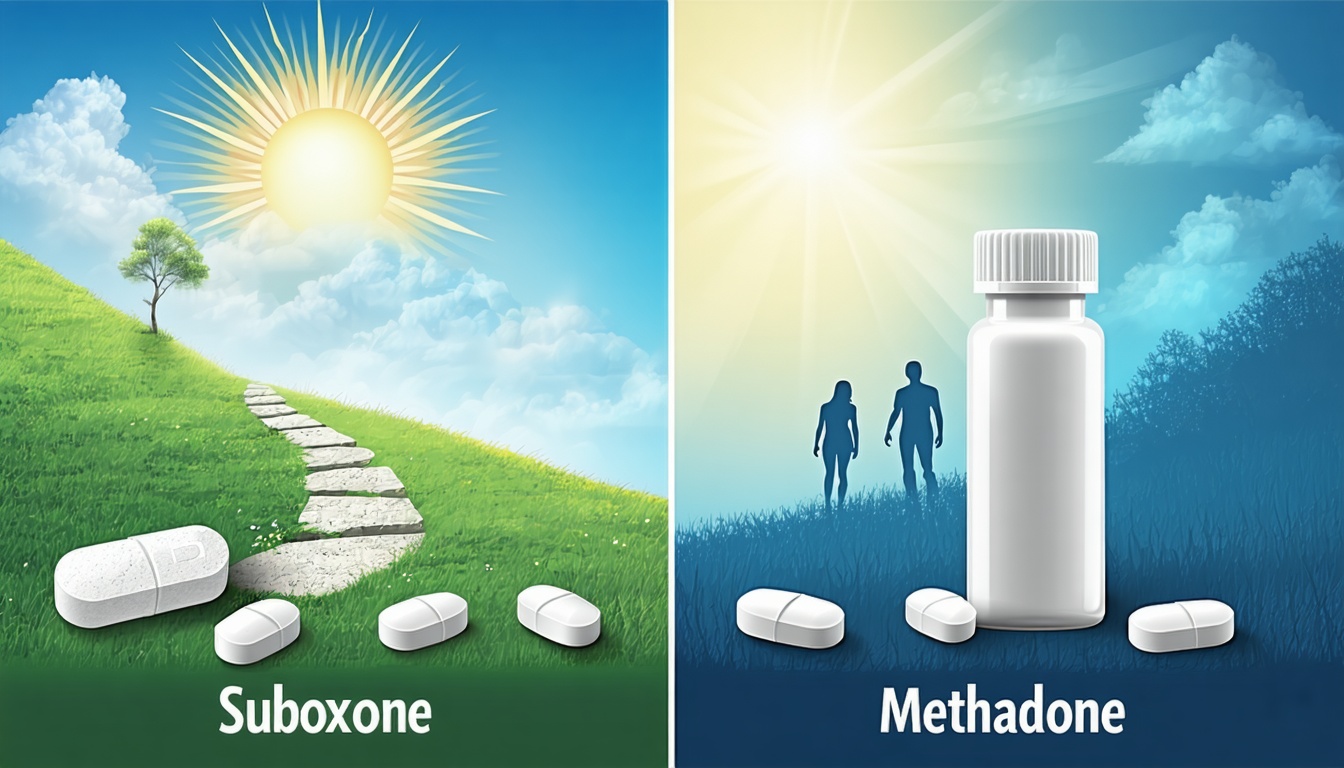Understanding Opioid Addiction Medications
In our commitment to providing the highest quality addiction treatment, we believe understanding the differences between medications like Suboxone and methadone is essential for effective recovery. Both medications are first-line treatments for opioid use disorder and typically lead to better outcomes for those who use them (Medical News Today).
Suboxone vs. Methadone Comparison
When comparing Suboxone and methadone, it is crucial to evaluate their fundamental characteristics. Below, we present a comparison of key features of both medications, emphasizing the differences that may influence recovery:
| Feature | Suboxone | Methadone |
|---|---|---|
| Type | Partial opioid agonist | Full opioid agonist |
| Addictiveness | Less addictive | More addictive |
| Respiratory Depression Risk | 1-10% of patients (American Addiction Centers) | Low risk |
| Withdrawal Symptoms | Typically milder | Usually more intense |
| Dosing Flexibility | Limited take-home options | Easier upfront with more take-home options (WebMD) |
| Recommended for Pregnant Women | Generally preferred (Medical News Today) | Can be used |
Key Differences in Recovery Outcomes
The recovery experience can differ based on medication choice. While both Suboxone and methadone aim to assist in reducing opioid cravings and withdrawal symptoms, the impact on recovery outcomes varies significantly between the two.
-
Addictiveness: Methadone is more addictive than Suboxone. Users may find it harder to discontinue methadone, as they can develop a greater dependency. Withdrawal symptoms from methadone may be intensified, requiring some individuals to remain on the medication long-term to avoid cravings and potential relapse (WebMD).
-
Flexibility: Patients often find methadone easier to manage due to its flexible dosing schedule. This flexibility allows for more take-home doses, which can effectively enhance patient compliance with treatment plans and reduce relapse risks (WebMD).
-
Respiratory Risks: Suboxone does carry a risk of respiratory depression, from 1-10% of patients. This potential risk necessitates immediate medical attention, which could affect a patient’s recovery trajectory (American Addiction Centers).
Choosing the right medication involves considering these differences. At Genesis Treatment Services, we prioritize collaborative discussions between patients and healthcare providers to determine the most suitable approach based on individual needs and treatment goals. For additional insights, visit our articles on understanding the role of methadone in opioid use treatment and what to expect from suboxone treatment at a licensed clinic.
Differences Between Suboxone and Methadone
Understanding the differences between Suboxone and Methadone is crucial for making an informed decision when considering treatment options for opioid addiction. Both medications play significant roles in medication-assisted treatment (MAT), yet their mechanisms, administration methods, and potential for addiction differ.
Mechanism of Action
Both Suboxone and Methadone are effective in blocking the effects of other opioids by filling opioid receptors in the brain. However, they operate differently within these receptors. Methadone is a full opioid agonist, which means it activates the opioid receptors entirely, providing significant relief from withdrawal symptoms and cravings (American Addiction Centers). In contrast, Suboxone contains buprenorphine, a partial agonist, that activates the receptor to a lesser extent, which can reduce the risk of misuse and overdose.
| Medication | Type | Primary Action |
|---|---|---|
| Suboxone | Partial Agonist | Partially activates opioid receptors |
| Methadone | Full Agonist | Fully activates opioid receptors |
Administration and Flexibility
Administration methods for these medications also differ significantly. Methadone typically requires daily visits to a licensed treatment center for dosing, which can be a barrier for some patients. In contrast, Suboxone can be prescribed by certified physicians and taken at home, offering more flexibility. This method allows individuals to incorporate treatment into their daily lives without the need for regular clinic visits (what to expect from suboxone treatment at a licensed clinic).
| Medication | Administration Method | Flexibility |
|---|---|---|
| Suboxone | At-home dosing with prescription | High |
| Methadone | On-site daily dosing at clinics | Low |
Addictiveness and Withdrawal Symptoms
Both medications are effective in treating opioid use disorder, though they present different risks. Methadone, while effective in managing withdrawal symptoms, carries a higher risk for addiction due to its full agonist nature. This means that it may lead to dependency on the treatment itself.
On the other hand, since Suboxone is a partial agonist, it tends to have a lower potential for addiction. However, it can induce withdrawal symptoms if taken while a patient is on full agonists, reflecting its partial activation of opioid receptors.
| Medication | Risk of Addiction | Withdrawal Symptoms |
|---|---|---|
| Suboxone | Lower | Possible if mixed with full agonists |
| Methadone | Higher | Manageable but can be severe if treatment is stopped suddenly |
Understanding these differences in the context of our commitment to providing the highest-quality addiction treatment is essential. For more information on how medication-assisted treatment supports long-term sobriety and stability, visit our article on how mat supports long-term sobriety and stability. Our team at Genesis Treatment Services is dedicated to helping individuals navigate these complex choices, ensuring a personalized and effective treatment plan.
Effectiveness of Suboxone and Methadone
Understanding the effectiveness of Suboxone and Methadone in treating opioid addiction is essential for informed decision-making. Both medications serve as first-line treatments for opioid use disorder and typically lead to better outcomes for individuals who engage with these therapies (Medical News Today).
Efficacy in Treating Opioid Addiction
Both Suboxone and Methadone have been proven effective at reducing opioid dependence and cravings. Research indicates that individuals using these medications can expect significant improvements in their recovery journey. The US Department of Veteran Affairs recommends these medications as primary treatments due to their efficacy in promoting long-term sobriety.
Impact on Opioid Use Reduction
Studies show that individuals on agonist medication-assisted treatments, including either Suboxone or Methadone, experience a notable reduction in illicit opioid use. By the end of a five-year follow-up period, these individuals report using opioids nearly 0 days per month, compared to around 12 days per month for those not receiving treatment. This stark contrast emphasizes the transformative role that these medications can play in recovery (Recovery Answers).
| Treatment Type | Opioid Use (Days per Month) | Reduction in Cravings |
|---|---|---|
| On Suboxone/Methadone | 0 | Significant |
| Not on Treatment | 12 | Minimal |
Retention Rates and Treatment Outcomes
Retention in treatment programs is a crucial factor influencing overall recovery success. Methadone and Suboxone have demonstrated high retention rates, which lead to better health outcomes. The guidelines suggest that achieving the appropriate daily dosage in the initial days of treatment can eliminate withdrawal symptoms and suppress cravings effectively. Common doses of buprenorphine typically range from 2 mg to 16 mg per day.
High retention rates contribute to the likelihood of ongoing recovery and stability, highlighting the benefits of continuous care.
| Medication | Retention Rate | Common Dosage Range (per Day) |
|---|---|---|
| Suboxone | High | 2 mg to 16 mg |
| Methadone | High | Individualized, often higher |
Understanding the effectiveness of Suboxone and Methadone can help individuals and families make informed choices regarding their treatment options. At Genesis Treatment Services, we prioritize evidence-based approaches to ensure the best outcomes for those seeking recovery. For more in-depth information, explore our resources on understanding the role of methadone in opioid use treatment and what to expect from suboxone treatment at a licensed clinic.
Considerations for Choosing Between Suboxone and Methadone
In deciding between Suboxone and Methadone for opioid addiction treatment, we understand that multiple factors come into play. This section discusses patient-specific considerations, individual treatment goals, and the importance of healthcare provider collaboration.
Patient-Specific Factors
Individual circumstances significantly influence the choice of medication. We consider a patient’s history of opioid use, medical history, and personal preferences when recommending either Suboxone or Methadone. While Methadone is more addictive and may require long-term use to avoid withdrawal complications.
| Factor | Suboxone | Methadone |
|---|---|---|
| Addictiveness | Less addictive | More addictive |
| Dosage requirement | Higher doses for effectiveness | Could require lower doses |
| Supervision | Can be prescribed without supervision | Generally requires a structured program |
Treatment Goals and Preferences
Understanding the treatment goals is key to making an informed decision. Individuals seeking a flexible treatment plan may prefer Suboxone due to its availability outside specialized clinics. Those looking for a comprehensive long-term treatment strategy may find Methadone better suited to their needs. Both medications are effective tools for combating opioid addiction, but aligning the treatment choice with personal goals enhances the likelihood of successful recovery (Concerted Care Group).
| Treatment Goals | Preference for Suboxone | Preference for Methadone |
|---|---|---|
| Flexibility | High | Moderate |
| Ease of Access | High | Moderate |
| Long-term Strategy | Moderate | High |
Healthcare Provider Collaboration
Collaboration with healthcare providers is crucial for developing a successful treatment plan. We emphasize the importance of ongoing communication and support between the patient and their healthcare team. This partnership allows for the assessment of the effectiveness of the chosen medication, adjustment of dosages, and exploration of adjunct counseling options. Following the guidelines from the US Department of Veteran Affairs, achieving an optimal dose can help manage withdrawal symptoms, cravings, and reduce illicit opioid use (NCBI Bookshelf).
By assessing individual factors, aligning treatment goals with preferences, and ensuring collaborative healthcare provider relationships, we can effectively guide individuals toward the most appropriate medication for their recovery journey. For more information on treatment options, explore our articles on understanding the role of methadone in opioid use treatment and what to expect from suboxone treatment at a licensed clinic.
Success Stories with Suboxone and Methadone
Long-Term Treatment Outcomes
We have witnessed numerous success stories from our clients who have chosen Suboxone or Methadone as part of their recovery journey. Research shows that individuals on agonist medication-assisted treatment, whether buprenorphine (Suboxone) or methadone, were using opioids near 0 days per month by the end of a 5-year follow-up period. In contrast, those not on medication-assisted treatment reported using illicit opioids about 12 days per month (Recovery Answers).
Over the long term, both Suboxone and Methadone have demonstrated impressive abstinence rates. Approximately 60% of individuals initially prescribed Methadone and 50% of those given Buprenorphine remained abstinent from opioids after five years, based on negative toxicology screens and self-reported 30-day abstinence.
| Treatment Type | 5-Year Abstinence Rate |
|---|---|
| Methadone | 60% |
| Buprenorphine | 50% |
Client Experiences and Testimonials
Listening to our clients’ experiences underscores the effectiveness of medication-assisted treatment. Many have expressed how Suboxone or Methadone has transformed their lives. For instance, one client shared that after beginning treatment, their cravings reduced significantly, allowing them to regain control over their lives. Another client noted that consistent use of Methadone led to improved relationships and job stability.
Both Suboxone and Methadone provide significant advantages when compared to not receiving agonist medication-assisted treatment. On average, individuals on these treatments experienced about 8 fewer days of illicit opioid use per month when compared to those who were not on medication-assisted treatment (Recovery Answers).
These positive outcomes are supported by the US Department of Veteran Affairs’ guidelines, which recommend Methadone or Suboxone as first-line treatments for opioid addiction due to their efficacy in improving client retention, reducing illicit opioid use, and curbing cravings (NCBI Bookshelf).
Through our comprehensive approach and dedication to our clients, we help facilitate a successful recovery process, empowering individuals to achieve long-term sobriety and stability. For more information on how we can assist in your recovery journey, explore our resources on how MAT supports long-term sobriety and stability and using medication and counseling together: why it works.
Genesis Treatment Services: Your Partner in Recovery
At Genesis Treatment Services, we understand the complexities involved in overcoming substance abuse challenges. We prioritize providing people with the highest quality of addiction treatment, counseling, and therapy tailored to their needs. Our commitment to effective, evidence-based practices sets us apart in the field of addiction recovery.
Comprehensive Addiction Treatment Programs
Our comprehensive addiction treatment programs are designed to support individuals at every stage of their recovery journey. According to the National Institute on Drug Abuse, less than 20% of individuals with opioid use disorder receive medications for treatment. Factors such as stigma and barriers to traditional treatment contribute to these low rates. We aim to address these issues by offering accessible services, including telehealth appointments, to increase access to needed medications.
| Program Component | Description |
|---|---|
| Individual Counseling | One-on-one sessions focusing on personal recovery goals. |
| Group Therapy | Support from peers who understand the journey of addiction. |
| Family Therapy | Involvement of family members in the recovery process. |
| Education on Opioid Use | Informative sessions on the nature of addiction and recovery. |
Evidence-Based Approaches
Our treatment strategies are founded on the latest research and methodologies in the field. We focus on a comprehensive treatment plan that includes medication-assisted treatment (MAT) in combination with counseling and social support programs. This dual approach ensures holistic care, addressing both the physical and psychological aspects of addiction. As noted by the University of Arkansas for Medical Sciences, buprenorphine is a key component permitted for offering through SAMHSA-certified opioid treatment programs, ensuring we meet rigorous standards in our treatment practices.
Our evidence-based approaches can improve recovery outcomes significantly. Research shows that both methadone and Suboxone are first-line treatments for opioid use disorder and typically result in better outcomes for those who consistently engage with these treatments (Medical News Today).
Support for Co-Occurring Disorders
Recognizing that many individuals face co-occurring mental health disorders alongside substance abuse, we provide tailored support to address these challenges. Our evidence-based programs, as referenced by the Concerted Care Group, are specifically designed to integrate mental health treatment into our addiction recovery programs. This holistic approach helps our clients build a solid foundation for lasting recovery, as we address their needs in a supportive and understanding environment.
Choosing Genesis Treatment Services means committing to a comprehensive path to recovery. With our focus on evidence-based practices, personalized care, and an understanding of co-occurring disorders, we empower individuals to create lasting change in their lives. For more information on how we can help, explore our other resources, including insights on the science behind medication-assisted treatment (MAT) and transitioning from illicit opioids to clinic-based treatment.




